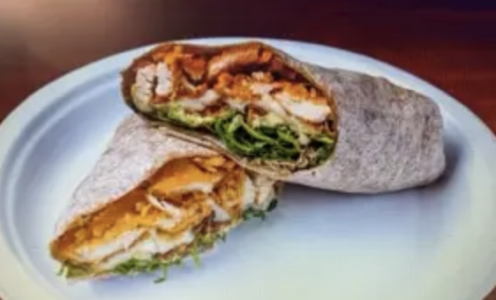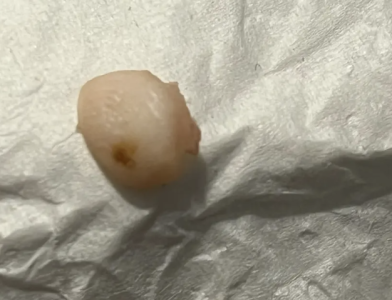
It's every diner's worst nightmare—biting into what you expect to be a perfectly ordinary chicken wrap, only to discover something that definitely shouldn't be there.
For 43-year-old New York real estate agent Mary Elizabeth Smith, that nightmare became reality last November when she claims to have found a human fingertip, complete with nail, in her takeaway lunch.
The disturbing incident has sparked a lawsuit that's raising serious questions about food safety standards and what happens when things go terribly wrong in commercial kitchens.
In this article
What actually happened?
The revolting November 17, 2023, incident happened to Corcoran realtor Mary Elizabeth Smith after she ordered the meal from Create in Astoria, according to court documents. Smith, who was simply trying to grab a quick lunch, says she immediately knew something was wrong when she bit into the wrap.
'She bit into [the wrap], could tell something wasn't right, and spit it out,' the lawyer said. What she discovered in her mouth was far worse than anyone could imagine—what appeared to be a human fingertip.
'This has left me very cautious about anything that I am eating'
The tissue was sent for testing, and Smith's attorney, Robert Menna, tells us his law office sent the fingertip to a lab, where testing confirmed it was human tissue from a woman. This DNA evidence forms the cornerstone of Smith's legal case against the café and its owners.
The medical response—why antiretroviral treatment?
One aspect of this case that might seem puzzling is Smith's immediate medical treatment. Smith, who said she's been cooking more meals at home these days, required intense antiretroviral therapy to fend off any potentially deadly diseases the severed fingertip may have exposed her to.
This isn't an overreaction—it's standard medical protocol. The United States Public Health Service guidelines recommend starting prophylactics up to 72 hours postexposure. The recommended regimen is emtricitabine plus tenofovir plus raltegravir for 4 weeks. When there's potential exposure to human tissue and bodily fluids, healthcare providers typically recommend antiretroviral treatment to prevent HIV transmission, along with testing for hepatitis and other blood-borne pathogens.
What is antiretroviral treatment?
Antiretroviral therapy (ART) is a combination of medications used to treat HIV. If you have HIV, antiretroviral therapy (ART) can make the virus undetectable and keep your immune system healthy. When used preventatively after potential exposure, it can stop HIV infection from taking hold. The treatment is also used to help HIV-positive individuals maintain their health and prevent transmission to others.
The restaurant fights back
The café owner isn't taking these allegations lying down. Menna says the restaurant claims they didn't have any female workers there on that day -- but Create's owner, Teddy Karagianni, denies such a story. He tells TMZ his female employees aren't on the line, but work as cashiers -- meaning it would be quite difficult for a female to chop her finger off into food in his kitchen.
The owner has called Smith's claims 'ludicrous' and even suggested she might have picked up the fingertip elsewhere. This sets up what could be a complicated legal battle, with DNA evidence on one side and the restaurant's operational procedures on the other.
A troubling pattern in food contamination cases
Unfortunately, Smith's experience isn't entirely unique. The food service industry has seen several high-profile cases of alleged human tissue contamination, though not all have been legitimate.
The most famous case involved Wendy's in 2005, when industry watchers were horrified when a woman from Las Vegas claimed to have found a finger in her bowl of Wendy's chili at a San Jose, California unit. However, that case turned out to be fraudulent.
As it turned out the woman, Anna Ayala, had a history of lawsuits, filing 13 in Nevada and California. Ultimately the finger was traced to an associate of Ayala's husband who had lost the finger in an industrial accident. Ayala later pleaded guilty to conspiring to file a false claim and attempted grand theft.
More recently, as he was enjoying his chicken sandwich from one of the chain's Ohio locations, David Scheiding allegedly discovered a surprise topping: a slice of human skin almost one inch long. It turns out the restaurant's manager had cut off a piece of his thumb while chopping lettuce, and instead of throwing out the tub of greens, proceeded to slap it on sandwiches and serve it to unassuming customers.
The legal landscape for food contamination
Winning a foreign object lawsuit isn't as straightforward as you might think. Personal injury lawsuits, such as those related to a foreign object found in food, are based on the legal theory of negligence. What this means is that in addition to proving injury by the foreign object, the plaintiff must also prove that the restaurant owner, chef, or manufacturer of the food was negligent in some way.
More specifically, the law requires that the victim has consumed some or all the foreign material and suffered a physical injury or illness as a result. Simply finding something disgusting in your food isn't enough—there must be demonstrable harm.
Legal requirements for food contamination cases
- Physical consumption of foreign material must have occurred
- Actual injury or illness must be demonstrated
- Negligence by the food preparer must be proven
- Medical documentation and evidence preservation are crucial
What's considered 'foreign' anyway?
Interestingly, not everything unexpected in food is legally considered a 'foreign object.' There have been a number of failed suits involving foreign bodies in food that could be expected—for example, a chipped tooth from a fishbone, or a mouth injury from a cherry pit in a slice of cherry pie.
Examples of foreign objects reportedly found include glass fragments, gravel, rocks, batteries, bolts, nails, buckshot, coins, needles, syringes, jewellery, toothpicks, wood splinters, plastic packaging material, staples, paperclips, wire and other pieces of metal, cigarettes, cigars, chewing gum, faeces, hair, blood, human fingers, fingernails, worms, roaches, spiders, insects, rodents, bones and other parts of animals.
Did you know?
Did you know?
According to the book, a bunch of asparagus may have up to six beetle egg sacs attached to it and still be safe to consume; ground oregano can have up to 1,250 insect fragments per 10 grams; and black currant jam can have up to 75 percent mould content in it before it is considered unsafe to eat. Food safety authorities actually have acceptable contamination levels for many products!
Protecting yourself as a diner
While cases like Smith's remain relatively rare, there are practical steps you can take to protect yourself when dining out or ordering takeaway.
Keep the packaging and receipt and document the foreign body with photographs. If you discover something that shouldn't be in your food, don't panic, but do take immediate action. The most important recommendation is to take the actual food that you found the foreign body within and place it in a safe container in your freezer. Unsurprisingly, the biggest issue in these types of cases is the destruction of evidence.
For older Australians, who may have different health vulnerabilities, it's particularly important to seek medical attention promptly if you've consumed any foreign material, especially anything that could pose an infection risk.
The impact on dining confidence
Smith's case highlights a broader issue about trust in our food system. In an interview with the New York Post, Smith expressed feeling permanently scarred by the event. She admits it took her a long time to work up the courage to eat chicken again, and she's become much more cautious about everything she eats.
For many older Australians, dining out is an important social activity and source of enjoyment. Cases like this can shake that confidence, even though they remain extremely rare in the broader context of millions of meals served daily.
Restaurant industry accountability
The food service industry takes these incidents seriously, even when they dispute specific claims. Manufacturers, stores, and restaurants are legally bound to exercise reasonable care when dealing with food for sale to consumers. If they are negligent and produce food contaminated with foreign matter, they can be held liable for any resulting injuries.
However, proving negligence can be challenging, especially when restaurants have established safety procedures and training protocols. The key often lies in whether proper procedures were followed and documented.
Looking ahead
Smith's lawsuit against Create and its parent company is still working its way through the New York court system. The outcome will likely depend heavily on the DNA evidence, witness testimony about the restaurant's procedures that day, and medical documentation of Smith's treatment and ongoing effects.
Whether this case proves to be legitimate or not, it serves as a reminder of the importance of food safety protocols in commercial kitchens and the serious consequences when things go wrong.
For diners, especially older Australians who may be more vulnerable to foodborne illnesses, the message is clear: trust your instincts, document any problems immediately, and don't hesitate to seek medical attention if you've consumed something concerning.
Original Article
https://7news.com.au/news/world/mar...er-in-her-cafe-bought-chicken-wrap-c-19796341
Fingertip discovered in NYC restaurant’s chicken wrap: lawsuit
Cited text: The revolting Nov. 17, 2023, incident happened to Corcoran realtor Mary Elizabeth Smith after she ordered the meal from Create in Astoria, according t...
Excerpt: 17, 2023, incident happened to Corcoran realtor Mary Elizabeth Smith after she ordered the meal from Create in Astoria
https://www.yahoo.com/news/articles/fingertip-discovered-nyc-restaurant-chicken-114521022.html
Fingertip discovered in NYC restaurant’s chicken wrap: lawsuit
Cited text: ... “She bit into [the wrap], could tell something wasn’t right, and spit it out,” the lawyer said.
Excerpt: 'She bit into [the wrap], could tell something wasn't right, and spit it out,' the lawyer said.
https://www.yahoo.com/news/articles/fingertip-discovered-nyc-restaurant-chicken-114521022.html
Woman Claims She Got Mouthful of Human Fingertip in Chicken Wrap Order
Cited text: Smith's attorney, Robert Menna, tells us his law office sent the fingertip to a lab, where testing confirmed it was human tissue from a woman.
Excerpt: Smith's attorney, Robert Menna, tells us his law office sent the fingertip to a lab, where testing confirmed it was human tissue from a woman.
https://www.tmz.com/2025/08/24/woman-claims-human-fingertip-chicken-wrap-lawsuit/
Fingertip discovered in NYC restaurant’s chicken wrap: lawsuit
Cited text: “It was horrifying for her.” · Smith, who said she’s been cooking more meals at home these days, required intense antiretroviral therapy to fend off a...
Excerpt: Smith, who said she's been cooking more meals at home these days, required intense antiretroviral therapy to fend off any potentially deadly diseases the severed fingertip may have exposed her to.
https://www.yahoo.com/news/articles/fingertip-discovered-nyc-restaurant-chicken-114521022.html
Antiretroviral Therapy (ART): How It Works & Side Effects
Cited text: Antiretroviral therapy (ART) is a combination of medications used to treat HIV. It can reduce your levels of HIV, keep your immune system healthy and ...
Excerpt: The United States Public Health Service guidelines recommend starting prophylactics up to 72 hours postexposure.
https://my.clevelandclinic.org/health/treatments/antiretroviral-therapy
Human Immunodeficiency Virus-1 Infection: Developing Antiretroviral Drugs for Treatment | FDA
Cited text: The .gov means it’s official.
Excerpt: Antiretroviral therapy (ART) is a combination of medications used to treat HIV. If you have HIV, antiretroviral therapy (ART) can make the virus undetectable and keep your immune system healthy.
https://www.fda.gov/regulatory-info...ion-developing-antiretroviral-drugs-treatment
Human Immunodeficiency Virus-1 Infection: Developing Antiretroviral Drugs for Treatment | FDA
Cited text: Before sharing sensitive information, make sure you're on a federal government site · The site is secure.
Excerpt: Antiretroviral therapy (ART) is a combination of medications used to treat HIV. If you have HIV, antiretroviral therapy (ART) can make the virus undetectable and keep your immune system healthy.
https://www.fda.gov/regulatory-info...ion-developing-antiretroviral-drugs-treatment
Woman Claims She Got Mouthful of Human Fingertip in Chicken Wrap Order
Cited text: Menna says the restaurant claims they didn't have any female workers there on that day -- but Create’s owner, Teddy Karagianni, denies such a story. H...
Excerpt: Menna says the restaurant claims they didn't have any female workers there on that day -- but Create's owner, Teddy Karagianni, denies such a story.
https://www.tmz.com/2025/08/24/woman-claims-human-fingertip-chicken-wrap-lawsuit/
Foreign Object in Food Injury Attorney in Los Angeles, CA
Cited text: If you broke your tooth or multiple teeth on an object in your food or you got sick from something foreign in your meal, contact a foreign object in f...
Excerpt: Industry watchers were horrified in 2005 when a woman from Las Vegas claimed to have found a finger in her bowl of Wendy's chili at a San Jose, California unit.
https://www.losangelescaraccidentattorney.co/foreign-object-food-attorney
Foreign Object in Food Injury Attorney in Los Angeles, CA
Cited text: If a restaurant worker breaches that duty of care, there may be an incident that leads to injuries. It is necessary that restaurant workers be diligen...
Excerpt: As it turned out the woman, Anna Ayala, had a history of lawsuits, filing 13 in Nevada and California.
https://www.losangelescaraccidentattorney.co/foreign-object-food-attorney
Finding Foreign Objects in Your Food—HG.org
Cited text: Human body parts may even show up in it.State laws vary widely as to which foods are allowed in foods and a knowledgeable attorney can explain whether...
Excerpt: As he was enjoying his chicken sandwich from one of the chain's Ohio locations, David Scheiding allegedly discovered a surprise topping: a slice of human skin almost one inch long.
https://www.hg.org/legal-articles/finding-foreign-objects-in-your-food-36179
Absurd Reasons People Sued Fast-Food Chains | Reader's Digest
Cited text: ... In 2017, a Queens resident sued Dunkin’ Donuts for the contents of its Angus Steak & Egg sandwich.
Excerpt: Personal injury lawsuits, such as those related to a foreign object found in food, are based on the legal theory of negligence.
https://www.rd.com/list/ridiculous-fast-food-lawsuits/
9 Surprising Fast-Food Lawsuits You Won’t Believe Are Real
Cited text: In 2012, the Doritos Locos Taco landed on the Taco Bell menu.
Excerpt: More specifically, the law requires that the victim has consumed some or all the foreign material and suffered a physical injury or illness as a result.
https://www.eatthis.com/unbelievable-fast-food-lawsuits/
9 Surprising Fast-Food Lawsuits You Won’t Believe Are Real
Cited text: She claimed it was understood that participation in and performance during these seminars was 'a prerequisite to promotion,' which Panda Express later...
Excerpt: There have been a number of failed suits involving foreign bodies in food that could be expected—for example, a chipped tooth from a fishbone, or a mouth injury from a cherry pit in a slice of cherry pie.
https://www.eatthis.com/unbelievable-fast-food-lawsuits/
McFat Litigation I—Pelman v. McDonald's Corp., 237 F.Supp.2d 512 (S.D.N.Y. Jan 22, 2003)
Cited text:
Excerpt: Examples of foreign objects reportedly found include glass fragments, gravel, rocks, batteries, bolts, nails, buckshot, coins, needles, syringes, jewelry, toothpicks, wood splinters, plastic packaging material, staples, paperclips, wire…
https://biotech.law.lsu.edu/cases/food/pelman01.htm
9 Surprising Fast-Food Lawsuits You Won’t Believe Are Real
Cited text: The fast food chain did, however, seek to distance itself from the third-party seminar company Alive Seminars following the incident.
Excerpt: According to the book, a bunch of asparagus may have up to six beetle egg sacs attached to it and still be safe to consume; ground oregano can have up to 1,250 insect fragments per 10 grams; and black currant jam can have up to 75 percent…
https://www.eatthis.com/unbelievable-fast-food-lawsuits/
9 Surprising Fast-Food Lawsuits You Won’t Believe Are Real
Cited text: But, one man, who happens to be a Mississippi attorney, took it to the next level.
Excerpt: Keep the packaging and receipt and document the foreign body with photographs.
https://www.eatthis.com/unbelievable-fast-food-lawsuits/
9 Surprising Fast-Food Lawsuits You Won’t Believe Are Real
Cited text: Some of these fast-food lawsuits hold up in court, while others are just plain (hold the cheese, lettuce, and tomato) ridiculous.
Excerpt: The most important recommendation is to take the actual food that you found the foreign body within and place it in a safe container in your freezer.
https://www.eatthis.com/unbelievable-fast-food-lawsuits/
9 Surprising Fast-Food Lawsuits You Won’t Believe Are Real
Cited text: Burger King countered, saying Coq Roq emulated a whole musical genre and many other artists, such as legendary hard rock band Kiss.
Excerpt: The most important recommendation is to take the actual food that you found the foreign body within and place it in a safe container in your freezer.
https://www.eatthis.com/unbelievable-fast-food-lawsuits/
Woman Finds Fingertip in Chicken Wrap, Sues Restaurant
Cited text: In an interview with the New York Post, Smith expressed feeling permanently scarred by the event.
Excerpt: In an interview with the New York Post, Smith expressed feeling permanently scarred by the event.
https://www.justdial.com/JdSocial/n...Chicken-Wrap-Sues-Restaurant/1756009982336865
Pre-Exposure Prophylaxis | HIV.gov
Cited text: Yes, in most cases, the cost of PrEP medication and services are covered by health insurance plans, Medicaid, and Medicare with no out-of-pocket costs...
Excerpt: Manufacturers, stores, and restaurants are legally bound to exercise reasonable care when dealing with food for sale to consumers.
https://www.hiv.gov/hiv-basics/hiv-...ation-to-reduce-risk/pre-exposure-prophylaxis
Have you ever encountered anything unexpected in your restaurant meal? How did you handle the situation, and what advice would you give to other diners? Share your experiences and thoughts in the comments below.









